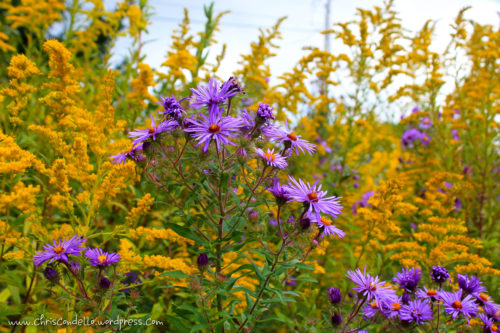The complementary colors of environment and society
Amanda Rockler ·By: Amanda Rockler
Complementary colors are any two hues positioned exactly opposite each other on the basic color wheel. Look at each color below, from left to right and right to left.

When a gradual amount of each color's complement is added, the resulting mixture becomes less and less intense until the color is totally neutral. Achieving the color you want is all a matter of balance. To me, this is analogous to the relationship between human systems and nature systems— sustainability is all a matter of balance between society, the environment, and the economy. Blending complementary colors is like the tenuous push and pull between society and nature. The importance of maintaining equilibrium so that the damage on either end is not irreparable but rather complementary. This week we learned about the environmental movement thru history and had a discussion about the works of Henry David Thoreau, Aldo Leopold, and Rachel Carson. In this post, I will try to synthesize our week 2 class discussion and lecture on the past, present, and future of coupled human-natural systems.
Let me set the stage.
In 2015, due to growing concerns about research linking cancer to certain chemicals, Montgomery County restricted the use of cosmetic pesticides on private lawns. In 2017, the County banned polystyrene food containers, and in 2019, the State of Maryland banned polystyrene foam food containers and cups (HB 109) and also passed SB516, requiring the State of Maryland to get half of its energy from renewable sources by 2030. On Friday, Howard County declared themselves a "Bee Sanctuary County" in response to the decline of pollinators and to combat colony collapse disorder. And the Chesapeake Bay, our "National Treasure," has been showing steady improvement in water quality. Extrapolate this across the planet— a lot has happened in just the most recent ten years, but we are still facing pressing environmental issues.
The Amazon is burning, the oceans are being depleted of fish and filled with trash, the air we breathe and the water we drink is contaminated, and our climate is warming at an unprecedented rate because of human activity. The list seems to go on and on and it seems like we put our own survival at risk, and things between humans and nature are wildly out of balance. In the 1986 book Cadillac Desert, a revolutionary book about water in the West, Marc Reisner writes, “What is remarkable, a hundred years later, is how little has changed.” If we could go back in time and right some of the wrongs that humans have imposed on our natural systems, would we? Could we? In Elizabeth Kolbert’s book The Sixth Extinction- An Unnatural History, she writes, “Though it might be nice to imagine there once was a time when man lived in harmony with nature, it’s not clear that he ever really did.” This really hit home as our class explored the history of the environmental movement this week.

As a recap, we are a blended class so we meet both in person and online. Check out our engaged class in the photo above! We started our second class watching MC Lars and Mega Ran's "Walden" rap music video. If you have not heard this song, I highly recommend it! You can think of MC Lars and Mega Ran’s "Walden" as being similar to Lin-Manuel Miranda’s "Hamilton". Our class discussion centered around Thoreau, Leopold, and Carson. Each a profound scholar, ahead of their time, they wrote about the complex and critical relationship between humans and nature. As a class we touched on several themes seen in the works including capitalism, self-reliance, stewardship, nature, preservation of wilderness, ethics, exploitation, propaganda, and society.
Although a majority of the class did not particularly enjoy reading Thoreau's Walden, mainly due to the author's writing style (I mean, he was fairly arrogant and it was written in 1854), there was lively discussion about his minimalist views. Thoreau focused on simplicity— buy what you need and no more, focus on nature rather than economic, wear the clothes on your back even when they are threadbare, and make your own food and shelter. Many in our class questioned whether this would be a reasonable expectation in contemporary society. We also discussed Maslow’s Hierarchy of Needs in relationship to Thoreau, and what stood out to me was that Thoreau’s Walden essentially identified Maslow’s work ahead of his time. Thoreau stressed a minimalist lifestyle focused on food, shelter, and water, which interestingly enough is also the basic criteria for survival in nature.

There was discussion around the idea that society should adopt a “better safe than sorry” approach, but that we often practice in the complete opposite manner. Why would we till the land to the extent where we deplete the soil and at the same time worry about sustainability problems with our agriculture crops? Why would we continue to create and utilize chemicals if we see the deleterious impacts they cause? It is these paradoxes that the three authors explored in their works and that we are still working on today.
At the end of the class discussion we had a fantastic surprise when our instructors transformed into Thoreau, Leopold, and Carson in front of our eyes and read a scripted play, written by Bill Dennison. The play was set at Thoreau’s cabin, where he invited Leopold and Carson to a dinner party to discuss life. The instructors really brought the characters to life and highlighted their respective beliefs: Leopold's desire to see “harmony between man and the land,” Thoreau's views on “understanding the essence of life,” and Carson's ability of “finding strength in nature”. The duality of man and nature is something that all of the authors seek to rectify in their works. They all find strength in nature and believe that to separate the human experience from nature would serve neither man nor nature.
We then shifted to the lecture portion of the class and explored the history of the environmental movement. Starting with the pastoral conservation years between 1850-1950, during which Barton and Beebe created the Bathysphere and Yellowstone (my favorite National Park) was established as the first National Park. During this era (1883), a prophetic John Wesley Powell went on record as saying, "there is not sufficient water to supply the land.” This observation was largely ignored (like a lot of what Carson, Leopold, and Thoreau said during their time) until after Dust Bowl in the 1920’s and 30’s when farms in the West failed due to insufficient water.
We moved past the first images of Earth taken in 1946, thru the environmental movement of 1950-1970 (which included Leopold and Carson), to the institutionalized environmental movement of 1970-1990, during which various federal agencies and the Clean Air Act and the Clean Water Act were established. We then launched into the modern global environmental movement from 1990- 2010, which includes heavy hitters such as Bob Ballard, Bill Rees, Bob Constanza, and Jeremy Jackson. Finally, we finished by talking about the contemporary environmental movement.
The environmental movement has indeed made some major strides in the years since Thoreau, Leopold, and Carson. Federal agencies have been created and environmental acts enacted, industries have implemented cleaner practices, environmental technology has improved, and science has advanced. Yet, at the same time, it feels like Thoreau, Leopold, and Carson’s concerns are still very much at the forefront of today’s environmental movement and there are still big questions remaining: Does big business drive the human relationship with the environment? Does a capitalistic society value nature? Are humans practicing a land ethic?
Society's relationship with nature is tenuous and we are still battling formidable environmental challenges. This feeling of complacency or stagnant change is complicated, and more than ever there is a need for an environmental ethic— to have society view themselves as part of a holistic ecosystem, and to change society's behavior for an environmental good. In the book Braiding Sweetgrass, Robin Wall Kimmerer writes about the relationship between goldenrods and asters. A powerful complementary companion planting, their natural beauty has fueled her career as a mother, scientist, writer, and professor. Kimmerer writes, “Science and art, matter and spirit, indigenous knowledge and Western science— can they be goldenrod and asters for each other? When I am in their presence, their beauty asks me for reciprocity, to be the complementary color, to make something beautiful in response.”
Can all of the disciplines studying society or nature find a complementary state? Can a balance be found? We do not have all the answers and so I leave you with the words of Aldo Leopold: “We shall never achieve harmony with the land, any more than we shall achieve absolute justice or liberty for people. In these higher aspirations the important thing is not to achieve but to strive.” And so we keep striving to preserve the complementary relationships and we keep striving to make something beautiful.

References:
1. Kimmerer, Robin. (2020). Braiding Sweetgrass: indigenous wisdom, scientific knowledge and the teachings of plants. S.l.: Penguin Books.
2. Kolbert, E. (2015). The sixth extinction: an unnatural history. London: Bloomsbury.
3. Leopold, A., & Leopold, L. B. (1993). Round River: from the journals of Aldo Leopold. Oxford: Oxford University Press.
4. Reisner, M., & Mott, L. (2017). Cadillac desert: the American West and its disappearing water. New York, NY: Penguin Books.
5. Thoreau, H. D. (1854). Walden. Boston, MA: Ticknor & Fields.
Next Post > Kicking off another semester of Environment and Society
Comments
-
Megan Munkacsy 6 years ago
Great introduction to the work of our class! I love that you brought in two other readings at the beginning and several local examples of society working to protect nature.
-
Taylor Gedeon 6 years ago
What a great blog, Amanda! You asked many striking questions, but the one that I really enjoy pondering is "Are humans practicing a land ethic?" I could generalize and say no, but it seems to me in this age of growing environmental awareness that many groups are striving to create and practice their own ethic. On a Sunday stroll in my own little neighborhood of Washington, D.C., I see vegans selling delicious food and advocating for the protection of animals, zero waste groups voluntarily collecting any and all compost, booths selling reusable straws, cleaning supplies, and other wares, and on and on. While these groups are perhaps not emblematic of the majority of the US, or global, population, they give me hope that a land ethic is possible. I agree with Leopold, we should continue to strive!
-
Hamani Wilson 6 years ago
Amanda,
I really enjoyed reading your blog. The connection between your introduction of complementary colors and your conclusion of the way nature and society must find a complementary balance was very well illustrated. In response to Robin Walls question of "Science and art, matter and spirit, indigenous knowledge and Western science— can they be goldenrod and asters for each other?" I say yes. But I will take it step further and opine that combination of any of those options may be necessary to challenge the way we approach these relevant issues and seek that complementary balance.
-
Isabel Sullivan 6 years ago
Nice Amanda! The blog looks great! I love how you began with this idea of a balance of humans and nature and you explained this well with the color wheel. This balance is one of the most important steps in managing our impact on the environment. Though, like you said, we may all not enjoy reading Thoreau, his minimalistic approach would benefit the human population that over consumes. By limiting our consumption, we can hopefully mitigate some of the impacts we have on the environment.
-
Andrea Miralles 6 years ago
Braiding sweetgrass is an incredible novel, and ties in so well to this week's theme. How can hold up a mirror to our way of viewing the environment and make it so that our science, complements and equally considers/works with all other forms of knowledge.
As much as the colors on the color wheel to the goldenrods and the asters, I think this kind of course sets the stage for humans and environment to be studied in disciplines that allow for this kind of complementary relationship.
-
Faith Taylor 6 years ago
Overall your article was very well written and was effective in summarizing both current events, class lecture and outside sources. Which reading did you prefer and why? What points stuck out to you and why?
-
Enid Munoz 6 years ago
Excellent blog entry. The color wheel analogy at the beginning is stupendous. I really enjoyed how you tied the readings to modern day acts such as the Clean Water and Clean Air and Styrofoam bills. In addition, the Stockholm Convention bans all organic bioaccumulative pollutants which include practically all of the ones Carson; that would've made her proud.
-
Alison Thieme 6 years ago
Thanks for the insightful blog! When you question if we could or would primitive the wrongs humans have imposed on natural systems I ponder the relationship between humans and their environments that have existed for millennia. Are humans imposing wrongs by their mere presence?
-
Michael 6 years ago
I am not an experienced blog reader. So, I don't know what makes a good or bad blog. Regardless, I learned from reading your well-written and thoughtful blog and I liked very much your creativity. I learned about some new readings. I have heard Robin Kimmerer talk and after reading your blog I am going to order Braiding Sweetgrass. I can see I have much to learn.
Thanks,
Michael

